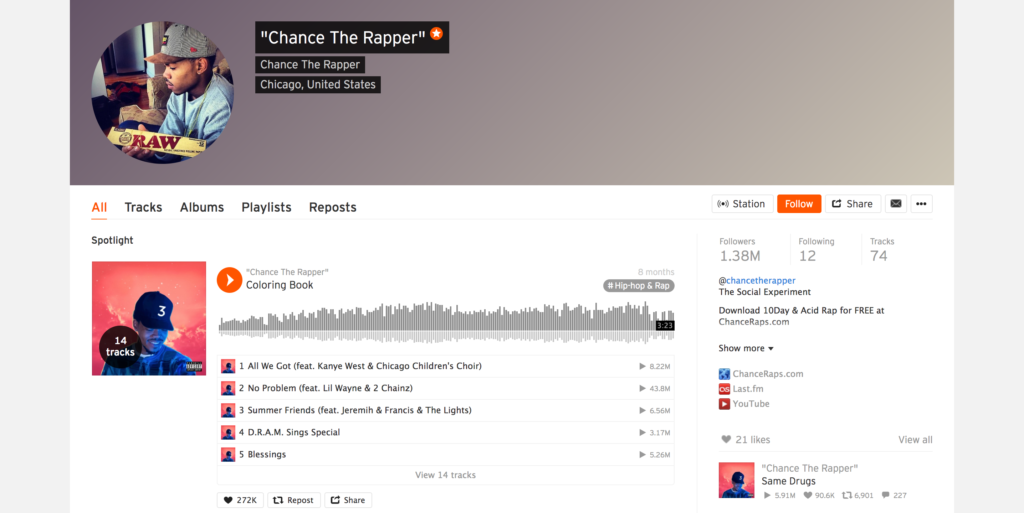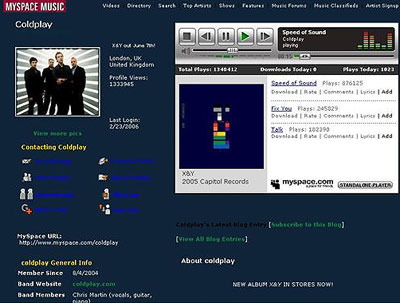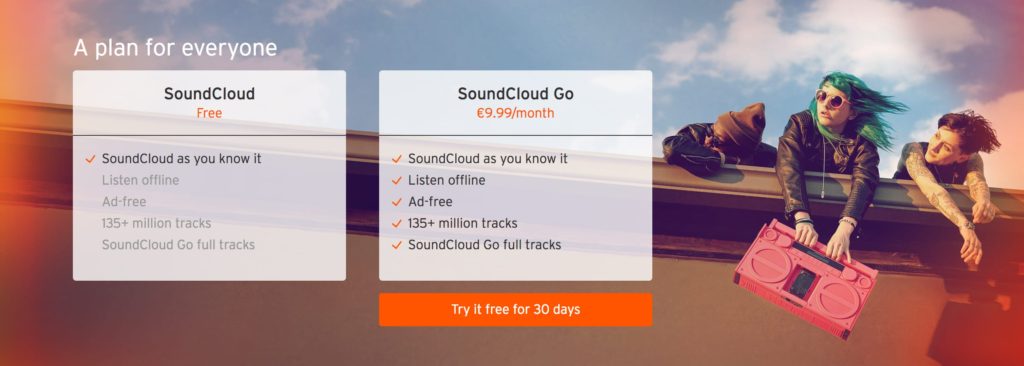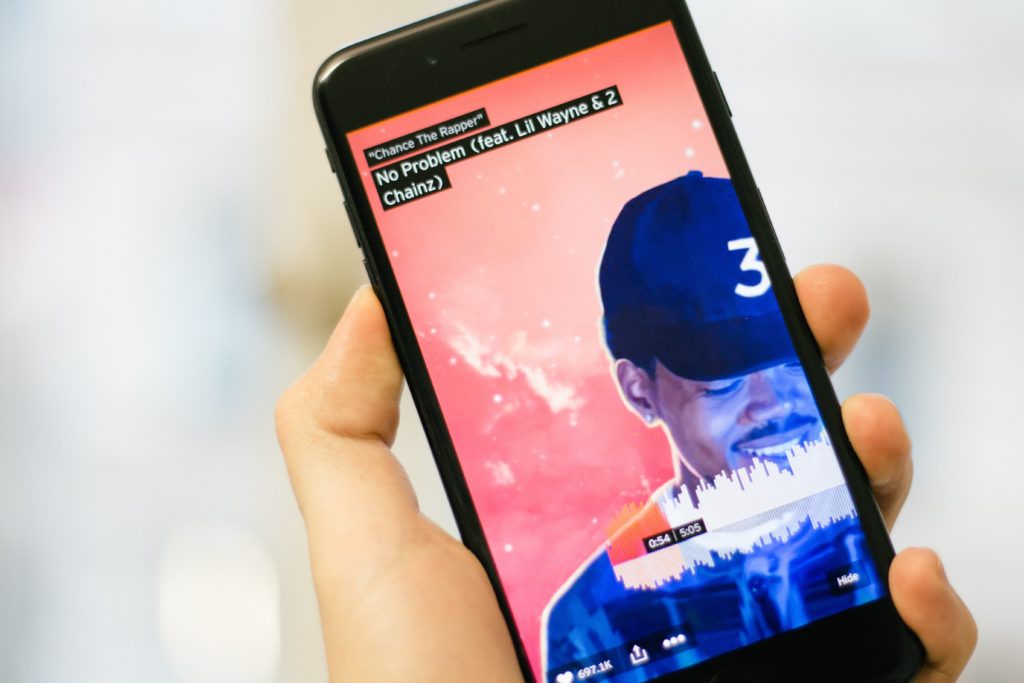SoundCloud in the news
Let’s take a look at some of the news headlines for SoundCloud over the last couple of months:
“SoundCloud in danger of running out of cash”
“Soundcloud’s top execs are leaving at an incredibly awkward time”
(QZ)
“Is SoundCloud Imploding? Top Execs Jump Ship as ‘Desperate’ Fundraising Begins”
You don’t have to be an expert analyst to understand that the company is going through severe financial difficulties — even looking past some of the the more sensationalist headlines.
Despite the doom and gloom SoundCloud holds a lot of good will in the eyes of users and indie artists, some of whom have built a career from scratch using the platform:
“This is for every indie artist. Shouts out to SoundCloud for holding me down. It’s another one, baby!”
(Chance the Rapper shouts out SoundCloud in Grammys acceptance speech – The Verge)

So this is the bottom line, then: SoundCloud is a product for the artists and the listeners. It was built out of passion, to solve a problem that its founders were facing, and has changed the way that young up-and-coming talent can grow and connect with their fanbase — and this is the part of the business that came first. But when it comes to converting such positive sentiment into revenue, things are far from working well.
The poster child of Berlin’s startup scene

There’s a café not 5 minutes from my apartment in Berlin, where the SoundCloud founders are rumoured to have put together the very first version of the cloud-based streaming app. Perhaps it’s for this reason that I feel some kind of connection to the company. Although having never worked there myself, a number of friends and acquaintances have joined and left over the years. It’s a staple of the city, and somewhere most people in tech seem to have some form of connection to. The company also plays its part when it comes to fostering the community by hosting a range of engineering meetups and other startup events.
For those in the Berlin tech scene, SoundCloud is seen as something of a flagship company for the city — for at least as long as I can remember. The tech industry here is still relatively immature compared to other European cities like London, which has given birth to a number of high-profile names and big exits. It’s still not clear when that will change, given the proportion of early-stage startups still dominating headlines.
Despite being such a recognized brand in Europe and worldwide, the SoundCloud product is hard to categorize in a world now shared with the big names and deep pockets of Spotify and Apple.
If SoundCloud wasn’t around, it’s still not clear who would take up the banner of “Berlin startup flagship” in their place.
Fact sheet
- Founded: 2007
- Launched: 2008
- Funding: $193M across 6 rounds
- Founders: Eric Wahlforss, Alexander Ljung
- Users (total): >175 million
- Users (paid): ? (not public)
- Catalog size: >135 million
Back in a different era…
It’s important to understand the space that SoundCloud was born into, back in 2008. The “YouTube of audio” was launched at a time when YouTube was barely a shell of what it is today. At a time when MySpace was dominating as a platform for independent musicians, SoundCloud was intended to provide a better way for creators to share and present their music to an audience on the web — something that still applies today.
In comparison to MySpace, music on SoundCloud was more shareable, compatible with social media and more “open” in general — something that became increasingly important over time with the rise of platforms like Facebook.
In many ways this focus has paid off for the platform; today, I’d argue that the variety of indie content from individual artists is the platform’s single unique selling point for consumers (but more on that later).

The elephant in the room: Revenue
Over the years, the team have had several attempts at monetizing the platform in a number of different ways.
Creator subscriptions (SoundCloud Pro)
As creators of a podcast, we pay for SoundCloud Pro at ChartMogul. With this subscription, you’re essentially just paying for more storage and stats on listeners. You’ll hit the limits of the free plan once you upload 3 hours of audio, so it’s basically a must-have for any serious creators on the platform.
I can’t help but think that getting creators to pay for storage is a backwards way of approaching monetization that only serves to limit the content on the platform. YouTube doesn’t charge for the number of hours of video uploaded to your account — they simply monetize on the user side through their ad platform.
Listener subscriptions (SoundCloud Go)
I was genuinely excited when SoundCloud Go was launched back in March 2016. But I arrived at the announcement page and was instantly confused by the majority of messaging:

- “Listen offline” – okay, this is a nice addition. Not worth the $9.99 alone though.
- “Ad-free” – I don’t currently hear any ads when using SoundCloud! How is this relevant? (I guess they just we’re running ads in my country at the time)
- “135+ million tracks” – This is quite clearly misleading, because they don’t compare how many tracks you get access to with the standard product. (my bet is that it’s not that much short of 135 million). So I’m left to comparing “135+ million tracks” with “not 135+ million tracks”. Great…
- “SoundCloud Go full tracks” – What?! To this day I can’t make sense of this. How is “SoundCloud Go full tracks” a benefit of SoundCloud Go? Didn’t we already cover that in the number of tracks above?!
So you can see why I didn’t buy. This is the LEAST compelling subscription pricing page I’ve seen for a long time! I’m an early-adopter proficient in tech, so how do they plan to sell this to… my Mum, for example?!
It’s too vague. I pay £10/month for Spotify. If someone told me I could pay £15/month for “even more tracks”, how am I supposed to understand if that’s a valuable proposition for me?
In reality, what they’re really suggesting is that they’re adding access to licensed tracks from the various record company deals they’ve signed (UMG, Sony, Warner etc.). But how is the user supposed to make this distinction?
I can’t help but feel like the company made some serious concessions to close the various deals they needed with each record company – features like paid-only content are clearly there to appease the rights holders, and for listeners only serve to confuse and frustrate.
Streaming audio ads
Following in Spotify’s footsteps, SoundCloud inserts streaming ads in between tracks for free users of the service.
Actually, when you look at the type of product SoundCloud represents, this form of monetization seems to make the most sense. SoundCloud has:
- The largest catalog of content of any streaming music service
- Free, user-generated content
- Some licensed content mixed in
There’s definitely another streaming platform with very similar characteristics: YouTube.
How is YouTube monetized? By running ads in its free user-generated content. (Okay, I know there’s YouTube Red, the premium subscription too, but that still represents a minor chunk of the platform’s revenue at this point).
For whatever reason, SoundCloud has failed to imitate the YouTube model work effectively. This could be due to reasons of scale, or subtleties in the audio format when compared to video. Or the product execution.
User experience woes

The core user interface of SoundCloud hasn’t changed considerably over the years, and while the web experience was never renowned for its elegance, it remains functional without too many surprises.
The mobile app however… well where do I start? All you have to do is read some of the blog comments from the announcement back in 2014 when the latest re-design went live. Here is just one of many comments on the post:
“SoundCloud’s new app is one of the most unfortunate business decisions I have ever seen a company make. It seems they have forgotten that without the musicians that upload music there wouldn’t be people to listen.”
The backlash was extensive, and almost entirely targeted towards the removal of features that artists relied upon, and the addition of a new, completely unintuitive user interface. The mobile app confuses me on almost a daily basis when I tap the wrong thing, swipe the wrong way or play a track without meaning to. And I’ve been using it since 2014! I don’t think I’ve felt this way since trying to use Snapchat for the first time.
SoundCloud is the only streaming audio platform I’ve used that has a feed, i.e. I can see a chronological stream of new tracks that are posted and recommended by people I follow. I like that! One of the main problems I have is with discovery. With so much user-created and indie content on the platform, my ability to find and play new music that fits my taste profile is shockingly low.
So what went wrong?
1. Shift in focus to directly compete with licensed streaming platforms
The pivot towards including licensed tracks on SoundCloud means competing with the big players in the space (Spotify, Apple Music, Google Play music) in a much more direct fashion.
Spotify touts 43 million paying subscribers (out of over 100 million accounts overall), and is still struggling to break even at that scale with its licensing model. Given the mixed messaging around SoundCloud Go (see above), it’s not completely surprising that the service is rumored to have no more than a few hundred thousand paying listeners – although no official numbers exist for this yet.
2. Scattered attempts at monetization
As highlighted above, each separate attempt at monetization has effectively attacked the product from every possible angle, leaving a fragmented user experience. The result is that users suffer from a sense of penny-pinching, pushed to part with their money at every opportunity.
3. Poor product evolution and vision
This is in all likelihood a result of the search for reliable revenue mentioned above. As a listener, it’s not clear to me what SoundCloud is any more. Where does it fit into the streaming music landscape? It doesn’t feel like a product that can stand on its own as an alternative to Spotify or Apple Music, but it’s still asking for ten of my hard earned dollars every month.
4. A big bet on converting free users to paid
If SoundCloud was to succeed in the launch of paid subscriptions (SoundCloud Go), they needed to convert a serious number of their free users over to paid accounts. Spotify is incredibly proud of its proposed free-to-paid conversion rate of 20-25% — which dwarves most other similar freemium businesses.
In the recent Financial Times report, analyst Mark Mulligan, founder of Midea Research stated:
“It will never get conversion rates [from free to paid] anywhere close to Spotify’s 20-25 per cent… The best it could ever hope for was 2 to 3 per cent, and in doing so it will alienate much of its userbase.”
It’s not clear what kind of conversion rate SoundCloud Go has seen in the months since launch, but the outlook isn’t promising.
What can subscription businesses learn from this?
1. Consumer subscriptions require unparalleled scale
In a market where margins are virtually non-existent, your business may not be remotely viable unless you’re the single dominant player in the market. Spotify has eaten up a large chunk of the music streaming market, but even at 43 million paying subscribers is struggling to balance the economics in their favour.
2. Don’t drive your pricing communication from the business side
Your subscription offering needs to be communicated in a crystal-clear way. This runs from the actual Pricing page through every part of Marketing communication and into the product itself. The positioning of the paid subscription needs to be communicated from the consumer’s perspective — even if it’s driven from the business side. Thinly-veiled monetization strategies are obvious.
3. Freemium: Don’t assume free users can be converted to paid users
Consumer subscriptions generally only work well when the value of the paid service in comparison to any alternatives is overwhelmingly high. One good example of this is Netflix — for a single monthly fee you get such a vast, high-quality library of content that you can consume to your heart’s desire.
As has been said many times from both a B2C and B2B perspective, users who sign up for your free plan are not necessarily the same segment of users who would sign up for a paid plan. They may have no intention to ever pay for such a service, but are quite happy to make the most of your free offering. Focusing on freemium growth without a solid plan for converting said free users means you’re building a high level of risk into your business model.
What now?
Over the last few months we’ve seen signs that time may be up for the company – at least in its current form. According to a filing for SoundCloud Ltd in January 2017, the company’s net loss grew to $52M in 2015, outpacing a very slow growth in revenue (to $22M).
Worryingly, the average annual salary grew nearly 20% to ~€90K in 2015. That’s a surprisingly-high average for a company headquartered in Berlin, where living costs and average salaries are generally lower than other European capitals.
The company has recently taken on more senior hires, such as former Google Exec Holly Lim, joining as the company’s first CFO, in a clear bid to build a revenue-generating machine and secure future funding.
Regardless of the above, SoundCloud has two things of considerable value to businesses and investors in the media space: A lot of passionate, active users and a huge library of content. With these assets, there’s hope that the team can raise some form of funding – given a solid plan for the near-term future of the product – albeit with a lower valuation than expected.
My bet is we’ll be seeing some SoundCloud-focused headlines before Q1 is up.
Written while listening to a 2-hour bootleg deep house mix, on SoundCloud.

